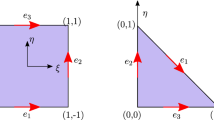Summary
In recent years the role of a convenient objective rate of objective quantities has been passionately discussed. There is a large number of well-justified formulations, e.g., [8], [13], [16]. For an overview of some selected derivatives see, e.g., [21]. However, unreliable results obtained in specific computations [11] complicate the right choice. Moreover, from a physical point of view there exist some additional requirements on time derivatives besides the principle of objectivity [5]. In this paper we try to show that there is a need for using corotational rates. For that purpose we give different approaches. In an application to the aforementioned facts we prove that only the Hencky strain [6] can have an objective corotational rate. We do that by identifying the objective strain rate and the deformation rate. Moreover, the spin involved in this rate is the logarithmic spin as defined in [23].
Similar content being viewed by others
References
Bertram, A.: Axiomatische Einführung in die Kontinuumsmechanik. Mannheim: Wissenschaftsverlag 1989.
Bowen, R. M., Wang, C.-C.: Introduction to vectors and tensors, vol. 1+2. New York: Plenum Press 1976.
Dafalias, Y. F.: A missing link in the macroscopic constitutive formulation of large plastic deformations. In: Plasticity today (Sawczuk, A., Bianchi, G., eds.), pp. 135–151, Udine, Italy, 27–30 June, 1983. Proc. International Centre for Mechanical Sciences London: Elsevier 1985.
Eringen, A. C.: Nonlinear theory of continuous media. New York: McGraw-Hill 1962.
Guo, Z.-H.: Time derivatives of tensor fields in nonlinear continuum mechanics. Arch. Mech. Stosow.15, 131–163 (1963).
Hencky, H.: Über die Form des Elastizitätsgesetzes bei ideal elastischen Stoffen. Z. Techn. Phys.9, 214–247 (1928).
Hill, R.: On constitutive inequalities for simple materials—I. J. Mech. Phys. Solids16, 229–242 (1968).
Jaumann, G.: Geschlossenes System physikalischer und chemischer Differentialgesetze. Akad. Wiss. Wien Sitzber.IIa, 385–530 (1911).
Lee, E. H.: Finite deformation effects in plasticity analysis. In: Plasticity today (Sawczuk, A., Bianchi, G., eds.), pp. 61–74, Udine, Italy, 27–30 June, 1983. Proc. International Centre for Mechanical Sciences London: Elsevier 1985.
Lehmann, Th.: Zur Beschreibung zeitabhängiger Vorgänge in der klassischen Kontinuumsmechanik. ZAMM42, T108-T110 (1962).
Lehmann, Th.: Anisotrope plastische Formänderungen. Romanian J. Techn. Sci. Appl. Mech.17, 1077–1086 (1972).
Marsden, J. E., Hughes, T. R. J.: Mathematical foundations of elasticity. Englewood Cliffs: Prentice-Hall 1983.
Naghdi, P. M., Wainwright, W. L.: On the time derivatives of tensors in mechanics of continua. Quart. Appl. Math.19, 95–109 (1961).
Naghdi, P. M.: Recent developments in finite deformation plasticity. In: Plasticity today (Sawczuk, A., Bianchi, G., eds.), pp. 75–83, Udine, Italy, 27–30 June, 1983. Proc. International Centre for Mechanical Sciences London: Elsevier 1985.
Ogden, R. W.: Non-linear elastic deformations. Mineola, New York: Dover 1997.
Oldroyd, J. G.: Finite strains in an anisotropic elastic continuum. Proc. R. Soc. London (A)202, 345–358 (1950).
Prager, W.: An elementary discussion of definitions of stress rate. Q. Appl. Math.18, 403–407 (1960).
Schieße, P.: Einige Bemerkungen zur Kettenregel bei Zeitableitungen isotroper Tensorfunktionen. ZAMM78, 419–425 (1998).
Stumpf, H., Hoppe, U.: The application of tensor algebra on manifolds to nonlinear continuum mechanics-Invited survey article. ZAMM77, 327–339 (1997).
Tsakmakis, C.: Über inkrementelle Materialgleichungen zur Beschreibung großer inelastischer Deformationen. PhD thesis. VDI-Fortschrittsberichte Reihe 18, Nr. 36 Düsseldorf: VDI-Verlag 1987.
Wegener, K.: Zur Berechnung großer plastischer Deformationen mit einem Stoffgesetz vom Überspannungstyp. PhD thesis. Techn. Univ. Braunschweig 1991.
Xiao, H.: Unified explicit basis-free expressions for time rate and conjugate stress of an arbitrary Hill's strain. Int. J. Solids Struct.32, 3327–3340 (1995).
Xiao, H., Bruhns, O., Meyers, A.: Logarithmic strain, logarithmic spin and logarithmic rate. Acta Mech.124, 89–105 (1997).
Zaremba, S.: Sur une forme perfectionée de la théorie de la relaxation. Bull. Int. Acad. Sci. Cracovie124 594–614 (1903).
Author information
Authors and Affiliations
Rights and permissions
About this article
Cite this article
Meyers, A., Schieße, P. & Bruhns, O.T. Some comments on objective rates of symmetric Eulerian tensors with application to Eulerian strain rates. Acta Mechanica 139, 91–103 (2000). https://doi.org/10.1007/BF01170184
Received:
Issue Date:
DOI: https://doi.org/10.1007/BF01170184




